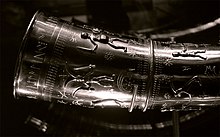Gjallarhorn


In Norse mythology, Gjallarhorn (Old Norse: [ˈɡjɑlːɑrˌhorn]; "hollering horn"[1] or "the loud sounding horn"[2]) is a horn associated with the god Heimdallr and the wise being Mímir. The sound of Heimdallr's horn will herald the beginning of Ragnarök, the sound of which will be heard in all corners of the world. Gjallarhorn is attested in the Poetic Edda, compiled in the 13th century from earlier traditional material, and the Prose Edda, written in the 13th century by Snorri Sturluson.
Attestations
Gjallarhorn is attested once by name in the Poetic Edda while it receives three mentions in the Prose Edda:
Prose Edda
In the Prose Edda, Gjallarhorn is mentioned three times, all mentions occurring in Gylfaginning.
In chapter 15, the enthroned figure
In chapter 27 of Gylfaginning,
In chapter 51, High foretells the events of Ragnarök. After the enemies of the gods will gather at the plain Vígríðr, Heimdallr will stand and mightily blow into Gjallarhorn. The gods will awake and assemble together at the thing.[5]
Archaeological record

A figure holding a large horn to his lips and clasping a sword on his hip appears on a stone cross from the Isle of Man. Some scholars have theorized that this figure is a depiction of Heimdallr with Gjallarhorn.[6]
A 9th or 10th century Gosforth Cross in Cumbria, England depicts a figure holding a horn and a sword standing defiantly before two open-mouthed beasts. This figure has been oft theorized as depicting Heimdallr with Gjallarhorn.[7]
Theories and interpretations

Scholar
See also
- The Snoldelev Stone, a 9th-century runestone featuring a unique three-horned symbol.
- The American Football team based in Minneapolis, use a large horn called the Gjallarhorn during home games at the U.S. Bank Stadium. It is blown during the opening ceremony alongside the Skol, Vikingsfight song.
Notes
- ^ Orchard (1997:57).
- ^ Simek (2007:110).
- ^ Faulkes (1995:17).
- ^ Faulkes (1995:25). Lindow (2002:143) comments that the Old Norse term employed for the instrument refers to "a long brass instrument that would answer today to an unvalved trumpet".
- ^ Faulkes (1995:54).
- ^ Lindow (2002:168).
- ^ Bailey (1996:86-90).
- ^ Simek (2007:110—111).
References
- American-Scandinavian Foundation.
- ISBN 0-460-87616-3
- Bailey, Richard N. (1996). England's Earliest Sculptors. University of Toronto. ISBN 0-88844-905-4.
- ISBN 0-19-283946-2
- ISBN 0-19-515382-0
- ISBN 0-304-34520-2
- Thorpe, Benjamin (Trans.) (1866) The Elder Edda of Saemund Sigfusson. Norrœna Society.
- Schach, Paul (1985). "Some Thoughts on Völuspá" as collected in Glendinning, R. J. Bessason, Heraldur (Editors). Edda: a Collection of Essays. ISBN 0-88755-616-7
- ISBN 0-85991-513-1
- ISBN 0-48643-431-1
